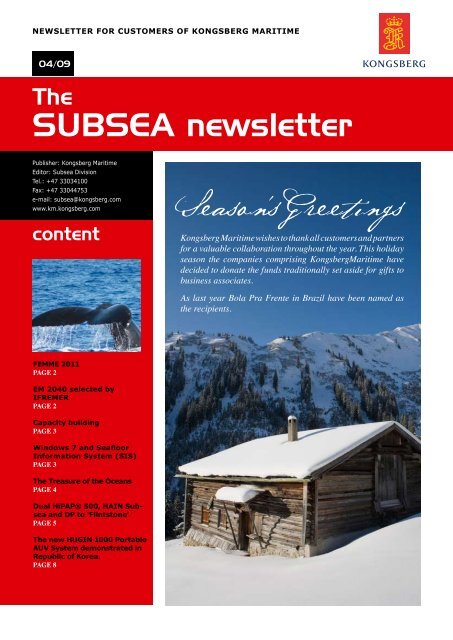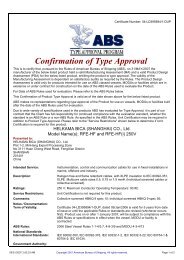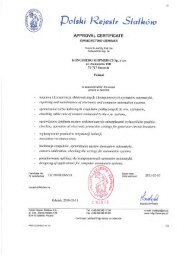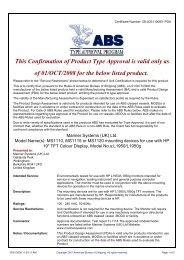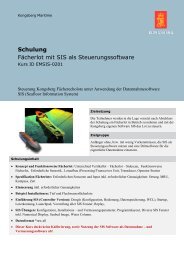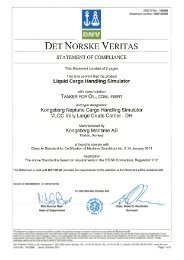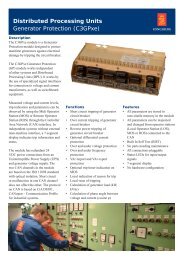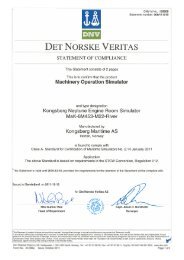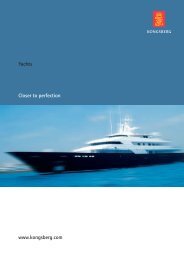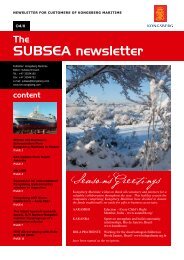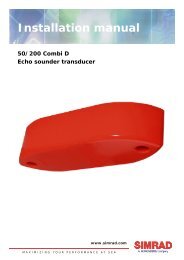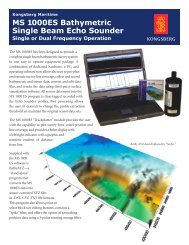No. 4 - December2009 - Kongsberg Maritime
No. 4 - December2009 - Kongsberg Maritime
No. 4 - December2009 - Kongsberg Maritime
Create successful ePaper yourself
Turn your PDF publications into a flip-book with our unique Google optimized e-Paper software.
NEWSLETTER For customers of kongsberg MARITIME<br />
04/09<br />
The<br />
SUBSEA newsletter<br />
Publisher: <strong>Kongsberg</strong> <strong>Maritime</strong><br />
Editor: Subsea Division<br />
Tel.: +47 33034100<br />
Fax: +47 33044753<br />
e-mail: subsea@kongsberg.com<br />
www.km.kongsberg.com<br />
content<br />
Season’s Greetings<br />
<strong>Kongsberg</strong> <strong>Maritime</strong> wishes to thank all customers and partners<br />
for a valuable collaboration throughout the year. This holiday<br />
season the companies comprising <strong>Kongsberg</strong><strong>Maritime</strong> have<br />
decided to donate the funds traditionally set aside for gifts to<br />
business associates.<br />
As last year Bola Pra Frente in Brazil have been named as<br />
the recipients.<br />
FEMME 2011<br />
PAGE 2<br />
EM 2040 selected by<br />
IFREMER<br />
PAGE 2<br />
Capacity building<br />
PAGE 3<br />
Windows 7 and Seafloor<br />
Information System (SIS)<br />
PAGE 3<br />
The Treasure of the Oceans<br />
PAGE 4<br />
Dual HiPAP® 500, HAIN Subsea<br />
and DP to ‘Flintstone’<br />
PAGE 5<br />
The new HUGIN 1000 Portable<br />
AUV System demonstrated in<br />
Republic of Korea.<br />
PAGE 8
The SUBSEA NEWSLETTER page 2 DECEMBER 2009<br />
The SUBSEA NEWSLETTER page 3<br />
DECEMBER 2009<br />
FEMME 2011<br />
ACS system <strong>No</strong> 100 delivered<br />
Capacity building<br />
<strong>Kongsberg</strong> <strong>Maritime</strong> is pleased to<br />
announce that the FEMME 2011<br />
Multibeam User Conference will<br />
take place in Trondheim, <strong>No</strong>rway,<br />
5th – 8th April 2011. Invitations will<br />
be sent out in August/September<br />
2010 and a web page for information<br />
and online registration will be<br />
established.<br />
As before, presentations by users<br />
of <strong>Kongsberg</strong> <strong>Maritime</strong> multibeam<br />
echo sounders will constitute a<br />
very central part of the conference,<br />
so we invite you to send suggestions<br />
of topics, abstracts and<br />
other ideas to the paper committee:<br />
helge.uhlen@kongsberg.com.<br />
If you have any questions about the<br />
conference or would like to discuss<br />
possible presentations please<br />
contact torbjorn.kjar@kongsberg.com<br />
or nina.hovland@kongsberg.com.<br />
The type approved acoustic control system<br />
(ACS) is designed for acoustic control<br />
of blow out preventor (BOP) and<br />
other subsea production units requiring<br />
a control system. Two major subsystems<br />
build up the system: The surface part and<br />
the subsea part depth rated to 4000m.<br />
Each of these two subsystems has transceivers<br />
connected to acoustic transducers.<br />
The total system is designed based<br />
on the principle of full dual redundancy<br />
– “two of everything”.<br />
The subsea unit controls several different<br />
functions with readback, monitors<br />
We are pleased to announce that we have<br />
been awarded the contract to supply the<br />
EM 2040 to IFREMER - French Institute<br />
for Exploitation of the Sea for use on its<br />
AUV, ‘ISE Explorer’.<br />
“We decided on the EM 2040 due to its<br />
modular concept, which makes it easy<br />
to integrate with an AUV. Its multi frequency<br />
operation with real time motion<br />
compensation, water column data,<br />
6000m depth rating and its general high<br />
analogue inputs and has additional<br />
functionality such as sequence control,<br />
auto shutdown etc. An advanced<br />
acoustic telemetry link provides a reliable<br />
communication in noisy and reverberant<br />
offshore environments. The<br />
system is available for both Emergency<br />
BOP Control and Surface BOP Control.<br />
The ACS system is delivered as low<br />
frequency (LF) or medium frequency<br />
(MF) systems.<br />
Since the early 80’s <strong>Kongsberg</strong> <strong>Maritime</strong><br />
has now delivered more than 100<br />
ACS systems.<br />
EM 2040 selected by IFREMER<br />
acoustical performance gave us a good<br />
feeling that this was the right choice for<br />
IFREMER this time,” said Chef de servide,<br />
Dr. Jan Opderbecke.<br />
The 10th Meso American & Caribbean<br />
Sea Hydrographic Commission Meeting<br />
took place in Bridgetown, Barbados,<br />
3rd – 6th <strong>No</strong>vember 2009. Supported<br />
by the International Hydrographic<br />
Bureau, it is mainly a meeting for<br />
reporting National status on hydrographic<br />
and navigation issues, such as<br />
navigational charts and collection of<br />
data, etc. As part of the conference,<br />
the industry is invited to participate as<br />
observers and to give technical presentations<br />
to support the capacity building<br />
in the region.<br />
Find out more here :<br />
http://www.iho-machc.org/welcome.html<br />
Prior to the meeting, CARIS and<br />
<strong>Kongsberg</strong> <strong>Maritime</strong> AS had agreed<br />
to take the capacity building one step<br />
further by mobilizing a complete EM<br />
3002 multibeam echo sounder configuration<br />
with sensors for data acquisition<br />
and a full CARIS software setup for the<br />
processing and presentation of the acquired<br />
data.<br />
The Port of Bridgetown, through Captain<br />
George Fergusson, had kindly<br />
made one of the port’s pilot boats available<br />
for the EM 3002 installation and<br />
a one week of survey. Over three days,<br />
an EM 3002, Seapath 200 with dGPS<br />
corrections and associated sensors were<br />
installed on the pilot boat. The system<br />
was tested and calibrated, and during<br />
the five days of the conference the<br />
participants from the 20 participating<br />
countries went onboard to learn about<br />
modern seabed mapping techniques.<br />
Several areas outside Bridgetown<br />
including parts of the approaches for<br />
large cruise ship were surveyed. All<br />
the acquired data was processed with<br />
CARIS software and presented to all<br />
Windows 7 and Seafloor<br />
Information System (SIS)<br />
With the arrival of Windows 7, Windows<br />
XP will eventually fade away. As the PCs<br />
delivered with our multibeam echo sounders<br />
use XP today, a strategy for moving to<br />
Windows 7 has to be made.<br />
The SIS topside application version 3.7<br />
will be compiled and tested on Windows<br />
XP whilst Version 3.8 will be compiled<br />
and tested on Windows 7, including the<br />
64-bit version.<br />
participants, and the final results were<br />
compared with the existing navigational<br />
charts.<br />
The whole operation was very successful,<br />
and everybody accepted <strong>Kongsberg</strong><br />
<strong>Maritime</strong> as the leading supplier of<br />
modern seabed mapping systems.<br />
The objective of our<br />
strategy to incorporate<br />
Windows 7<br />
within our SIS application<br />
is to deliver<br />
it with a next<br />
generation of PCs<br />
that will run the<br />
64-bit version of<br />
Windows 7.<br />
SIS itself will still be a 32-bit application,<br />
and the information we have so<br />
far is that it will work on both XP and<br />
Windows 7.<br />
We will continue to support the delivered<br />
XP systems for the forthcoming versions<br />
of SIS, and existing installations will be<br />
able to upgrade the SIS topside application.
The SUBSEA NEWSLETTER page 4 DECEMBER 2009<br />
The SUBSEA NEWSLETTER page 5<br />
DECEMBER 2009<br />
The three technolgies, wide swath bathymetry, side scan sonar and single beam echosounder<br />
The Treasure of the Oceans<br />
Posidonia is the foundation of marine<br />
ecosystems. It is a priority habitat and<br />
fundamental to the ecological balance of<br />
the seas. Recent research has established<br />
a new scientific method for its detection,<br />
classification and volume estimation.<br />
Simrad Spain proposes the use of<br />
hydroacoustic technology for this purpose.<br />
Why is posidonia vital to the marine<br />
ecosystem?<br />
The grass meadow is a ‘climax community’,<br />
representing the highest level of<br />
development and complexity that a marine<br />
ecosystem can reach. Posidonia in<br />
coastal ecosystems plays a major role for<br />
several reasons:<br />
• Thanks to its leaf development, the<br />
environment frees up to 20 liters of<br />
oxygen per day, per m2 of meadow<br />
• It produces and exports biomass both<br />
to surrounding ecosystems and to<br />
greater depths<br />
• It provides shelter and breeding<br />
grounds for many fish, cephalopods,<br />
bivalves, gastropods, echinoderms and<br />
tunicates<br />
• It consolidates the seafloor to help offset<br />
costs and excessive sediment transport<br />
due to coastal currents<br />
• It acts as a barrier, attenuating the<br />
force of currents and waves and thus preventing<br />
coastal erosion<br />
• It dampens the waves through the layer<br />
of dead leaves deposited on the beaches,<br />
which protects against erosion, especially<br />
during winter storms.<br />
The disappearance of grasslands has<br />
negative effects not only on the microecosystem<br />
itself but also on linked<br />
ecosystems; just think that the loss of a<br />
single meter of grassland can lead to the<br />
disappearance of several meters of beach<br />
due to erosion. Furthermore, regression<br />
of grasslands involves a loss of biodiversity<br />
and deterioration of water quality.<br />
The research on Oceanic Posidonia has<br />
seen a major boom in recent years. The<br />
importance of the flora in the marine<br />
ecosystem balance has become obvious<br />
and is beyond question. Among the underwater<br />
flora of our environment the<br />
Posidonia Oceanica is of special importance.<br />
It is a species that has a powerful<br />
attraction to be endemic to the Mediterranean<br />
and the key to ensuring biodiversity<br />
of the seabed. It is subject to many<br />
threats, given the increase in human activities<br />
such as chemical spills, discharge<br />
of brine from desalination plants, construction<br />
of port infrastructure and indiscriminate<br />
trawling. In addition, other<br />
non-human factors such as the encroachment<br />
of invasive species to the Posidonia<br />
also pose a threat to their survival.<br />
We must consider the slow processes of<br />
growth and recovery of a damaged area.<br />
It is estimated that the Posidonia extends<br />
through the meadows at the rate of one<br />
centimeter per year, so if you try to retrieve<br />
a square foot, it would take a century<br />
to achieve your goal.<br />
Scientific studies by hydroacoustic systems<br />
Until recently, scientists have used methodologies<br />
based on diving and capturing<br />
video images in their study areas. Current<br />
technology has improved the qualitative<br />
and quantitative research capabilities,<br />
and the application of different hydro<br />
acoustic detection systems provides a<br />
variety of information. Documents published<br />
by the ‘European Acoustics Association’,<br />
highlighted the excellent results<br />
obtained in detecting and classifying<br />
seabed vegetation by combined application<br />
of acoustic methods. They combined<br />
a single beam echosounder, which<br />
enables classification of the seafloor and<br />
its vegetation, a multi-beam sonar, which<br />
generates micro-relief, and a side scan<br />
sonar, imaging the seafloor reflectivity<br />
and thus enabling the spatial classification<br />
of seafloor types and vegetation.<br />
The data from these systems are merged<br />
and processed, resulting in 3D images of<br />
the same quality and precision as found<br />
in the field of biomedicine.<br />
Quantitatively speaking, this technology<br />
can work simultaneously with oceanographic<br />
parameters. All this information<br />
is linked to the presence and quantity of<br />
Posidonia. As for the quantitative method,<br />
prospecting new technologies allow<br />
a wide area of study while minimizing<br />
data collection time. Thanks to the<br />
digital storage of all data acquired during<br />
the survey, one can make historical<br />
databases that allow monitoring of the<br />
expansion or reduction in the length of<br />
the field of underwater flora. You can<br />
also study how quality varies over time<br />
by comparing contemporary data with<br />
the previous sampling. Many authors<br />
emphasize the new possibilities opened<br />
by the combined application of different<br />
acoustic systems. Each of the systems<br />
available, depending on their features,<br />
offers various types of information about<br />
the flora.<br />
KONGSBERG and Simrad systems applied<br />
to new methodologies<br />
In an experiment conducted in France<br />
by the company in collaboration with<br />
TS SEMANTIC GESMA, for defence<br />
purposes, the aim was to detect mines<br />
hidden in the vegetation. Several systems<br />
were combined to cross-correlate<br />
the signals from different types of bottoms<br />
(sand with and without plants,<br />
rocks) with samples obtained at different<br />
depths and with different settings of<br />
the systems (transmit power and pulse<br />
length between them). Acoustic systems<br />
combined in this test were:<br />
• A side scan sonar<br />
• The GeoAcoustics shallow water wide<br />
swath bathymetry system GeoSwath<br />
Plus, which simultaneously acquires bathymetry<br />
with a swath width of 12 times<br />
the water depth and geo-referenced side<br />
scan data<br />
• The scientific high-precision echosounder<br />
Simrad EK60<br />
The side scan sonar shows the reflectivity<br />
of the seafloor and discriminates areas<br />
where there are plants or sand. The<br />
GeoSwath Plus system provides bathymetry<br />
and geo-referenced side scan data.<br />
Both datasets can be merged to generate<br />
a three dimensional image representing<br />
the bathymetry and backscatter of the<br />
seafloor. This unique feature allows us<br />
to correlate the three-dimensional data<br />
with the location and extent of Posidonia<br />
meadow areas.<br />
The scientific probe records the acoustic<br />
pulses to generate a profile of the<br />
KM Naval AUV AUV product range Conference 2010<br />
The HUGIN & REMUS Family<br />
seafloor. These data are recorded simultaneously<br />
with the DGPS position.<br />
Since the sandy areas and vegetation<br />
meadows provide different signatures,<br />
by applying the algorithm analysis, it<br />
discriminates between different types<br />
of seafloor. In this first phase, it detects<br />
the presence of Posidonia. In that<br />
case the system estimates its height and<br />
abundance. The presence of Posidonia<br />
is limited to the depth to which sunlight<br />
reaches, the photic zone, so most of these<br />
studies are conducted in shallow water.<br />
This combined with the high resolution<br />
of the acoustic systems, generates maps<br />
that resemble virtual reality. This methodological<br />
concept corroborates that the<br />
innovations technology offers high performance<br />
and provides scientists with a<br />
new and improved ways to study. Moreover,<br />
these technologies enable the direct<br />
study of large areas with very high resolution,<br />
whereas the traditional approach<br />
of visual sampling was limited to very<br />
small zone and therefore the use of statistical<br />
extrapolation.<br />
The methodology provides several advantages:<br />
the mappings are very precise<br />
and there is no need to repeat the survey<br />
again and again to compare results.<br />
Another advantage is that it significantly<br />
reduces the costs of underwater inspections:<br />
divers, cameras, videos, etc. A direct<br />
scientific application is the fact that<br />
the concentration of plants has civil and<br />
military uses: the plants can hide mines<br />
placed on the seafloor and also alter the<br />
performance of the sensors used for detection<br />
(especially the laminaria species).<br />
<strong>Kongsberg</strong> <strong>Maritime</strong> is pleased to announce that the next KM AUV<br />
Conference will take place in San Diego, USA 4 - 8 October 2010. Plans<br />
and detailed program is still in progress and invitations will be sent out<br />
in March/April 2010.<br />
KM like to invite our customers and users of HUGIN and REMUS<br />
AUV`s to participate in the program, and we will therefore contact you<br />
direct in the near future.<br />
If you have any questions regarding the conference at this point, please<br />
contact; Ernest Petzrick, epetzrick@ hydroid.com or Lorna Banstra,<br />
LBandstra@hydroid.com
The SUBSEA NEWSLETTER page 6 DECEMBER 2009<br />
The SUBSEA NEWSLETTER page 7<br />
DECEMBER 2009<br />
Dual HiPAP ® 500, HAIN Subsea and DP<br />
to ‘Flintstone’<br />
on two independent measurements and<br />
a quality control. The dual system uses<br />
both transducers to measure the position<br />
of one single target (transponder) by<br />
separately controlling the beam forming<br />
and phase measurement for each system<br />
in parallel.<br />
New HiPAP Training in Aberdeen<br />
DEME Group ordered the dynamically<br />
positioned fall-pipe rock dumper<br />
‘Flintstone’ from Sembawang Shipyard,<br />
Singapore, in July 2008. She will<br />
be commissioned in early 2011 and be<br />
operated by Breda based Tideway BV,<br />
the offshore specialist company within<br />
DEME group.<br />
Flintstone has a load weight of 19,000<br />
ton and is specially designed for creating<br />
high precision structures on the sea<br />
bed, using rock and gravel in bulk, etc.<br />
Typically, the structures are rock capping<br />
and bedding on top of or underneath<br />
an oil/gas pipeline; rock tables for<br />
crossing pipe lines and gravel layers for<br />
wind turbine foundations etc.<br />
The vessel features two large rock bunkers<br />
on the main deck. In the centre of<br />
each rock bunker is a large Liebherr excavator,<br />
which discharges into a hopper<br />
fitted starboard of the rock dumper. The<br />
bulk of each rock bunker is transported<br />
to the central hopper by a longitudinal<br />
conveyor belt. Subsequently a 2000ton/h<br />
belt conveys the rock across the beam to<br />
the fall pipe. The ID 700 fall pipe hangs<br />
in the middle of a moonpool and the<br />
rock material falls through this pipe to<br />
the seabed. Accurate positioning of the<br />
fall pipe mouth is handled by an ROV.<br />
Huisman designs and builds the new<br />
Stone Dumping Unit. This is a tower<br />
like construction mounted over the<br />
moonpool, which allows the swift buildup<br />
and retrieval of the fall pipe, even<br />
in rough seas. Rock bulk production<br />
through the fall pipe is controlled by<br />
means of the rock handling system.<br />
Thanks to advanced <strong>Kongsberg</strong> Dual<br />
HiPAP 500, HAIN Subsea and DP system,<br />
and the comparatively high DP<br />
capability of the all electric propulsion<br />
based on 6 thrusters, Flintstone is able<br />
to track (a pipeline) with great accuracy<br />
and fast update rate at all times, which<br />
supports the quality of the subsea structures<br />
being built.<br />
Use of two HiPAP 500 transducers<br />
increases the electrical and acoustic<br />
redundancy, and also increases the accuracy,<br />
as it opens for redundant measurement<br />
with position estimation based<br />
HAIN Subsea combines the acoustic<br />
measurements from the Dual HiPAP<br />
500 and the readings from the sensors<br />
onboard the ROV in an optimum way.<br />
The navigation equations update the<br />
ROV position, velocity, heading and attitude<br />
almost continuously based on the<br />
readings from the Inertial Measurement<br />
Unit. The advanced Kalman filter corrects<br />
these values when new acoustic<br />
positions and readings from the other<br />
ROV sensors are available. This results<br />
in improved position accuracy and update<br />
rate compared to the acoustic measurements.<br />
The innovative self supporting fall pipe<br />
is a joint development of DEME/Boskalis<br />
and IHC Merwede. Thanks to this<br />
newly conceived fall pipe operations in<br />
water depths of up to 2000m are possible.<br />
From left: Conway Lawson, Training Manager, Technical, Keira Togneri, Training Instructor, Operations, Lee Tobin, Training Manager, Operations<br />
Kerry Johnston, Training Coordinator, Iain Fullerton, Training and Simulation Business Manager, Nikki Machell, Training Instructor, Technical.<br />
From early 2010, <strong>Kongsberg</strong> <strong>Maritime</strong><br />
Ltd, will be offering HiPAP Technical<br />
& HiPAP Operator (APOS) training<br />
courses on a regular scheduled basis<br />
from their new, custom fitted, Training<br />
and Marine Simulation Centre at<br />
Westhill, Aberdeen.<br />
A range of HiPAP courses are aimed at<br />
offshore, marine & construction surveyors<br />
& technicians, vessel electrical staff<br />
and DP operators, in order to provide<br />
participants an understanding of:<br />
• HiPAP (High Precision Acoustic<br />
Positioning) principles and training<br />
on the effective operation of the system<br />
in USBL and LBL modes using<br />
the APOS s/w<br />
• Offshore Loading using the HiPAP<br />
APOS s/w for Navigators and DP<br />
operators from shuttle tankers and<br />
standby vessels involved in different<br />
offshore loading operations<br />
• HiPAP 350 & HiPAP 500 system<br />
operating principles and the main<br />
SIS Operator course<br />
components of these systems, including<br />
transponders, and their maintenance.<br />
Why choose <strong>Kongsberg</strong> <strong>Maritime</strong><br />
Training Services?<br />
• Unique access to the latest <strong>Kongsberg</strong><br />
<strong>Maritime</strong> systems & operating software<br />
• Instructors with direct operational<br />
experience and knowledge of <strong>Kongsberg</strong><br />
<strong>Maritime</strong> systems<br />
• Custom designed training consoles<br />
and aids<br />
• Range of Nautical Institute approved<br />
DP courses<br />
• Courses designed for specific installations,<br />
vessels and their operational<br />
teams<br />
• Project specific training<br />
• Adds value to your investment in<br />
personnel and their individual<br />
development<br />
• Refresher training – continuity and<br />
update on the latest <strong>Kongsberg</strong><br />
<strong>Maritime</strong> systems<br />
• Course accommodation provided/<br />
recommended<br />
<strong>Kongsberg</strong> <strong>Maritime</strong> system training<br />
offers a broad range of benefits,<br />
including:<br />
• Develops operator skills and confidence<br />
• Enables better operational planning<br />
• Increases operational efficiency<br />
• Maximises system performance<br />
• Increases project productivity and<br />
profitability<br />
• Reduces overall operational risk<br />
• Motivates and aids the retention of<br />
employees<br />
• Prevents accidents and system failure<br />
due to operator error or mistake<br />
• Enhances company HSE profile and<br />
operational reputation<br />
• Reduces downtime and disruption to<br />
the project schedule<br />
• Reduces operational costs<br />
For further information contact Iain<br />
Fullerton at +44 (0)1224 617671 or Email:<br />
km.training.aberdeen@kongsberg.com<br />
We are pleased to announce another five day open SIS Operator course,<br />
which takes place in Horten, <strong>No</strong>rway, March 1st – 5th, 2010.<br />
The course will consist of four days of theory and one day of practical,<br />
hands-on training at sea. It will be held at our Training Center in<br />
Strandpromenaden 52, starting at 09:00 and finishing at 15:45 every<br />
day. The cost for the five day course is NOK 23,000 per person. We will<br />
enroll 8 participants in total.<br />
You can book your seat via email on km.training.horten@kongsberg.<br />
com, please include name of participant, company name, name of vessel<br />
and the invoice address.
The SUBSEA NEWSLETTER page 8<br />
DECEMBER 2009<br />
The new HUGIN 1000 Portable AUV System<br />
demonstrated in Republic of Korea<br />
heating systems to enable operations in<br />
Arctic environments, as well as air condition<br />
system for operations in tropical<br />
climate.<br />
Recent Demonstrations<br />
The HUGIN 1000 Portable AUV<br />
System was recently demonstrated in<br />
Korean waters. The operations were<br />
carried out by <strong>Kongsberg</strong>’s AUV<br />
Department in close cooperation with<br />
the Agency for Defense Development<br />
(ADD) in the Republic of Korea (ROK).<br />
HUGIN 1000 AUV Resting on Extended L&R Stinger<br />
HUGIN 1000 Portable AUV System<br />
The portable AUV system is fully containerized<br />
into one 20-foot ISO container<br />
for storage, battery management, vehicle<br />
maintenance and launch and recovery<br />
(L&R), and one 10-foot ISO container<br />
for mission planning, vehicle checkout,<br />
mission execution, and post-mission<br />
analysis (PMA). This advanced AUV<br />
system covers a wide range of operations<br />
like MCM, REA, route survey and highquality<br />
bathymetric mapping surveys in<br />
areas of interest.<br />
The main advantage of the HUGIN AUV<br />
is its small overall system footprint. This<br />
is primarily due to the multi-function 20-<br />
foot container, providing AUV storage,<br />
shipping, maintenance, battery charging,<br />
launch and recovery facilities, and<br />
furthermore due to compactness of the<br />
10-foot operations container, with only<br />
two operators needed for the entire<br />
operation.<br />
The system allows fast and easy mobilization<br />
onto vessels of opportunity due<br />
to ISO containerization, well-defined<br />
and simple interface points, and the<br />
self-sufficient nature of the system. The<br />
entire system fits on a standard truck, and<br />
can use all standard shipping methods,<br />
including overnight airlift to anywhere<br />
in the world.<br />
AUV operations are run directly from the<br />
10-foot ISO container, with no need to<br />
tie into a ship’s systems or internal spaces.<br />
In the portable system, a <strong>Kongsberg</strong><br />
High-Precision Acoustic Positioning<br />
(HiPAP) 350 system and a tow-fish<br />
transducer for acoustic communication<br />
are included, as well as a <strong>Kongsberg</strong><br />
SeaPath system for accurate ship reference<br />
position and attitude.<br />
The 20-foot container includes a twostage<br />
L&R “stinger” (hydraulically controlled<br />
hinged ramp) which allows AUV<br />
operations from vessels with a stern freeboard<br />
of up to 5 meters. Both ISO containers<br />
are insulated and equipped with<br />
The sea trials took place southwest of the<br />
city of Busan and covered both search<br />
for mines in shallow water and REA in<br />
deeper waters. The HUGIN AUV executed<br />
all test dives autonomously without<br />
problems in up to sea state 4.<br />
It took one week, from start of transportation<br />
in Horten to the HUGIN 1000 first<br />
touched the Korean waters, which is quite<br />
fantastic, Svein Otto Schjerven, Manager<br />
S & M HUGIN AUV`s explains. He<br />
continue; “ The first operation of this<br />
kind with the HUGIN 1000 system was<br />
a great success, and demonstrated fully<br />
the capacity of such an AUV system.”<br />
HUGIN 1000 Portable AUV System on<br />
the ADD vessel<br />
KONGSBERG MARITIME AS<br />
P.O. Boks 111 N-3194 Horten <strong>No</strong>rway Telephone +47 33 03 41 00 E-mail subsea@kongsberg.com<br />
www.km.kongsberg.com


